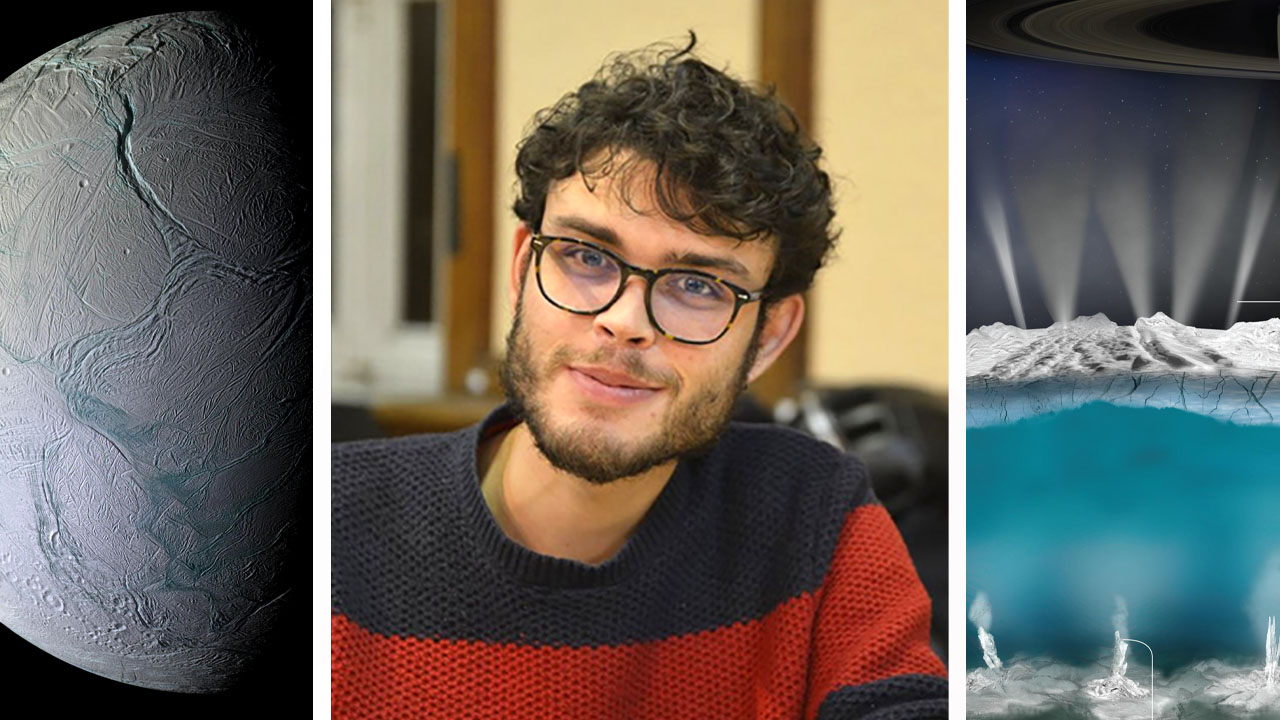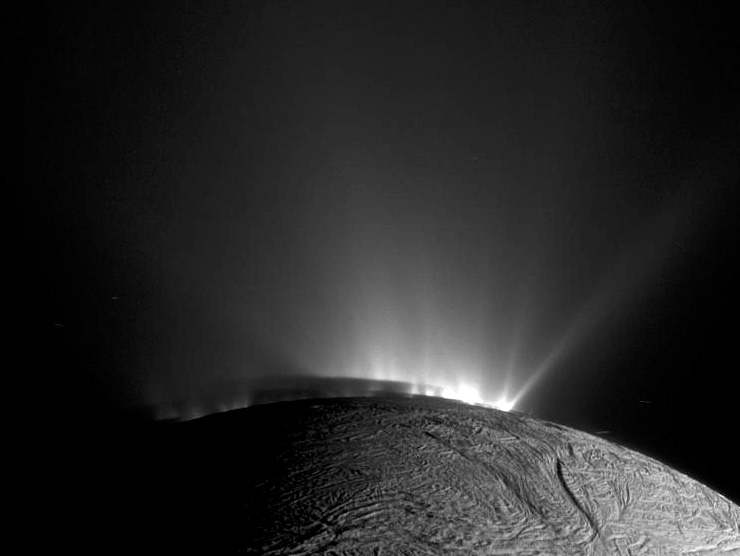
Antonin Affholder - kosmomagazine.it
We metAntonin Affholder, researcher of the Department of Ecology and Evolutionary Biology at University of Arizona inTucson (Arizona, USA).A team of researchers from the University of Arizona, led byAntonin Affholder, has published an article on The Planetary Science Journal (to read it click HERE), in which they explain how we might find the evidences of microbial life in the ocean of Enceladus (one of Saturn’s moons).
Between 2005 and 2017, NASA’s Cassini spacecraft discovered that Enceladus’s thick ice sheet hides a big and warm ocean of salty water that also releases methane, a gas that on Earth generally comes from microbial life. In particular, Cassini discovered water-rich plumes venting from the south polar region. Cryovolcanoes, near the south pole, shoot geyser-like jets of water vapor. More than 100 geysers have been identified.
What are the fundamental ingredients for life discovered in the ocean of Enceladus?
The ocean of Enceladus is thought to contain some small organic molecules (molecules that correspond to carbon atoms chained together- along with other elements, living organisms are composed of organic matter), as they are found in the plume. Additionally, Enceladus’s ocean harbors hydrothermal vents, a geological feature that exists on Earth, and that could have been the birthplace of life. Even if we do not know exactly what the ingredients to kickstart life are, we know that most of the elements that compose life are likely to be found in Enceladus’s ocean. These elements are carbon, hydrogen, nitrogen, oxygen, phosphorus and sulfur. Carbon is found in small organic molecules and in carbon dioxide that were found in the plume of Enceladus. Recent studies suggest that nitrogen and phosphorus could also be abundant (hydrogen and oxygen are abundant in water molecules). One could also consider that water is also a fundamental ingredient for life. Specifically, water is fundamental solvent for life as we know it. A solvent is the medium in which chemical reactions can happen. Enceladus has a global liquid water ocean, hence it is thought that it has both the right solvent, and the right elements to compose life and perform chemical reactions.
Credit: NASA’s Goddard Space Flight Center
How did you understand that the biomass present in the ocean of Enceladus could be lower than that of a whale?
Enceladus’s hypothetical hydrothermal vents could sustain conditions in which known organisms could survive and even grow. The growth of such a population is controlled by the flux of certain molecules that are released in hydrothermal environments. In particular, the organisms that we consider – methanogens – consume dihydrogen and carbon dioxide to produce energy that they then spend to synthesize biomolecules and perform other essential functions. Hence, the rate at which energy-bearing molecules are delivered to the environment is essential to calculate the size of the population that could inhabit the hydrothermal vents. Even if we do not know how much dihydrogen is produced in Enceladus’s hydrothermal vents, we know how much is produced in Earth’s hydrothermal vents and in lab experiments.
Taking this value as the maximum hydrogen production (and taking 0 as the minimum), we simulated the growth of a population of methanogens. We observed that typical simulations predicted populations that contain approximately 10 tons of carbon. We tried to find a relevant point of comparison on Earth, and found that whales typically contained about 10 tons of carbon. We decided to stick to this comparison because it was a fun one!

Credits: NASA/JPL/Space Science Institute
Is the Enceladus Ocean hot due to Saturn’s magnetic field?
Enceladus’s ocean is overall relatively cold, maybe 1 or 2 C. However, it is estimated that hydrothermal vents releasing water up to 90 C could exist. The source of heat for this hydrothermal fluid is likely something called “tidal dissipative heating”. The important mass of Saturn, and the orbit of Enceladus, generate intense tidal motion in Enceladus’s core in particular (but also in the ice). Just like tides move the oceans on Earth, tides deform Enceladus’s solid interior. The motion of solid rocks due to the tides generates heat is sufficient amount to power hydrothermal circulation of Enceladus’s ocean. Hence, it is not Saturn’s magnetic field that heats Enceladus’s ocean, but its gravitational influence on Enceladus’s interior!
NASA’s Cassini spacecraft has spotted many plumes, which appear to be spewing methane. Why is methane an important ingredient for life? We also know that methane may indicate the presence of microbial life, or a geochemical process such as volcanism or hydrothermal activity.
Methane was indeed found in Enceladus’s plumes by the Cassini mission. Methane is not exactly considered an important ingredient for life, as it not a nutrient for most of Earth’s life forms. However, most of the methane found on Earth is produced by living organisms (microbes called methanogens that are commonly found in the gut of ruminants such as cows, but also in rice paddies and of course hydrothermal vents as well as many other environments). Hence, finding methane is interesting for astrobiologists because few known non-life processes produce significant amounts of methane, whereas the biosphere produces large amounts of it.

Credits: NASA/JPL-Caltech/Space Science Institute
In your opinion, could the probable Enceladus Orbilander mission find evidence of the presence of life? What should he do to find them?
It is impossible to know for sure what a future mission will find (or else we would not have to send a mission!). We find that if a methanogenic biosphere exists at Enceladus’s seafloor, there could be a certain amount of certain molecules (amino-acids, in particular glycine) in the plume that could be measured by a mission like the Orbilander. Hence our conclusion is that if a mission like the orbilander does not find these molecules in the quantities that we predicted, then it is likely that the methane found in the plume does not originate from a population of Earth-like methanogens that would inhabit Enceladus’s seafloor. It is a little bit confusing, but as long as we do not have access to direct evidence (like diving in the ocean and look at what is there), the best we can do is make predictions – and see if they match.



